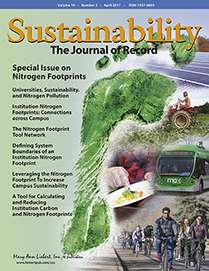Credit: Mary Ann Liebert, Inc., publishers
Researchers have developed a large-scale method for calculating the nitrogen footprint of a university in the pursuit of reducing nitrogen pollution, which is linked to a cascade of negative impacts on the environment and human health, such as biodiversity loss, climate change, and smog. The first completed university-wide nitrogen footprint results are reported in a special issue of Sustainability: The Journal of Record.
The special issue introduces a network of institutions participating in a coordinated and collaborative effort to utilize this novel nitrogen (N) footprint calculation method. Teams of authors provide original research, case studies, and commentaries on their experiences using the N footprint as a tool for education, research, and sustainability efforts.
In the article entitled "The Nitrogen Footprint Tool Network: A Multi-Institution Program to Reduce Nitrogen Pollution" Guest Editor Elizabeth Castner, University of Virginia, Charlottesville, and coauthors, describe the results of employing the newly created tool to determine the amount of nitrogen released from seven higher education institutions across the United States.
Guest Editor Allison Leach, University of New Hampshire, Durham, and coauthors, present the methodology for utilizing a combined carbon and nitrogen footprint assessment method in the article, "An Integrated Tool for Calculating and Reducing Institution Carbon and Nitrogen Footprints." The researchers discuss the results of applying this tool across institutions, comparing and correlating the findings for carbon and nitrogen consumption.
In an Editorial, James N. Galloway, PhD, University of Virginia, Charlottesville, past winner of the Tyler Prize for Environmental Achievement for his findings on nitrogen's wide-ranging effects on local and global ecosystems, states: "This special issue reports on the findings of the first cohort—seven schools that have completed the calculation and analysis of their N footprints." Why focus on universities initially? "A university is an interesting blend of consumers that are part of an entity that is itself a consumer of resources," explains Dr. Galloway. "A university can use their N footprint to educate the students. It provides research opportunities for the entire community and it can be used as a planning and management tool for institutional operations."
"The Guest Editors and the authors from the NFT Network have put forth a tool for institutions worldwide to first measure then mitigate their nitrogen loss to the environment," says Jamie Devereaux, Editor of Sustainability. "This measure of an N footprint is equally important as understanding an overall carbon footprint, and the tool created and tested by this group will pave the way for others."
More information: Elizabeth A. Castner et al, The Nitrogen Footprint Tool Network: A Multi-Institution Program To Reduce Nitrogen Pollution, Sustainability: The Journal of Record (2017). DOI: 10.1089/sus.2017.29098.eac
Journal information: Sustainability: The Journal of Record
Provided by Mary Ann Liebert, Inc























